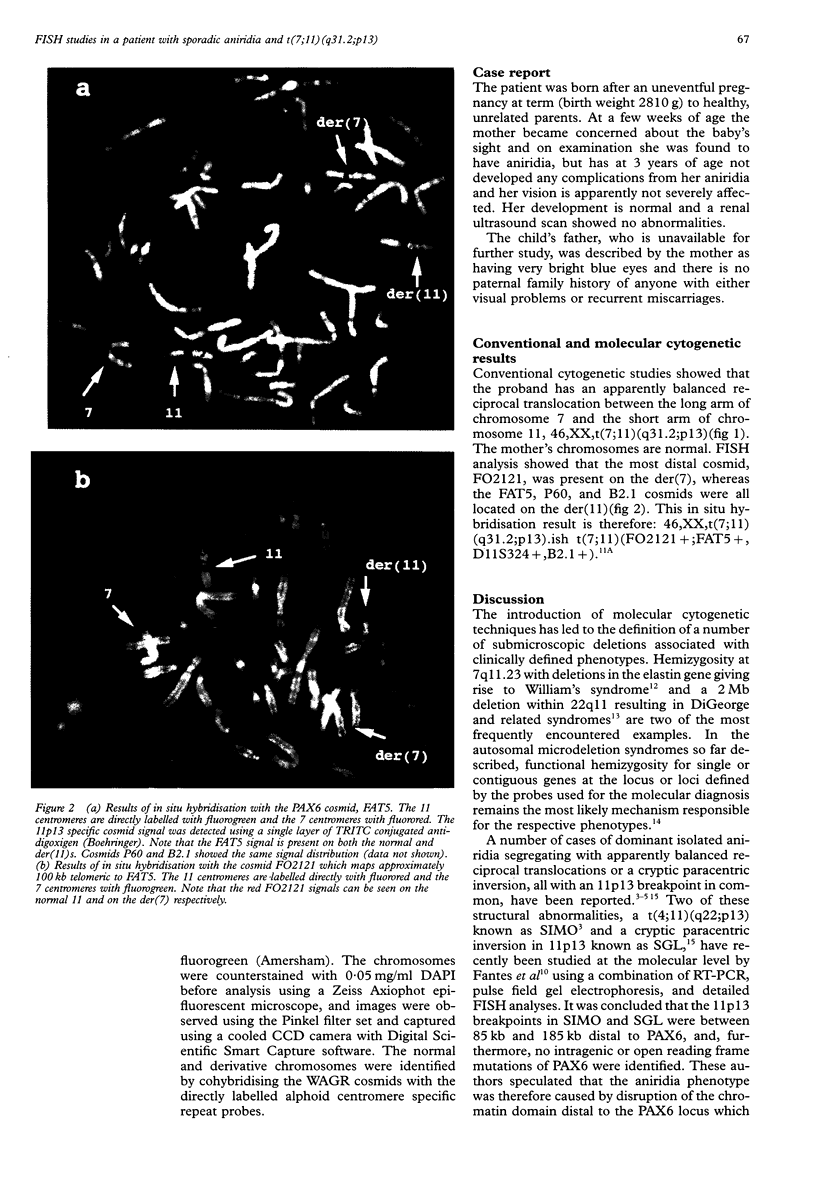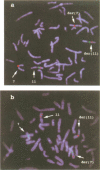Abstract
A 2 year old female presenting with bilateral sporadic aniridia was found to have an apparently balanced reciprocal translocation with a chromosome 11 breakpoint within band p13. Fluorescence in situ hybridisation (FISH) studies with distal 11p13 specific cosmids showed that the chromosome 11 breakpoint lay between the aniridia (PAX6) locus and a region approximately 100 kb distal to PAX6 defined by the cosmid FO2121. Although this patient did not have a detectable deletion within PAX6, her aniridia may have resulted from a disruption of the distal chromatin domain containing either enhancers or regulators for PAX6. This case may therefore be another example of aniridia caused by a position effect as recently described in two familial aniridia patients in which the phenotype cosegregated with chromosome abnormalities with 11p13 breakpoints.
Full text
PDF


Images in this article
Selected References
These references are in PubMed. This may not be the complete list of references from this article.
- Dillon N., Grosveld F. Chromatin domains as potential units of eukaryotic gene function. Curr Opin Genet Dev. 1994 Apr;4(2):260–264. doi: 10.1016/s0959-437x(05)80053-x. [DOI] [PubMed] [Google Scholar]
- Drechsler M., Meijers-Heijboer E. J., Schneider S., Schurich B., Grond-Ginsbach C., Tariverdian G., Kantner G., Blankenagel A., Kaps D., Schroeder-Kurth T. Molecular analysis of aniridia patients for deletions involving the Wilms' tumor gene. Hum Genet. 1994 Oct;94(4):331–338. doi: 10.1007/BF00201588. [DOI] [PubMed] [Google Scholar]
- Ewart A. K., Morris C. A., Atkinson D., Jin W., Sternes K., Spallone P., Stock A. D., Leppert M., Keating M. T. Hemizygosity at the elastin locus in a developmental disorder, Williams syndrome. Nat Genet. 1993 Sep;5(1):11–16. doi: 10.1038/ng0993-11. [DOI] [PubMed] [Google Scholar]
- Fantes J. A., Bickmore W. A., Fletcher J. M., Ballesta F., Hanson I. M., van Heyningen V. Submicroscopic deletions at the WAGR locus, revealed by nonradioactive in situ hybridization. Am J Hum Genet. 1992 Dec;51(6):1286–1294. [PMC free article] [PubMed] [Google Scholar]
- Fantes J. A., Oghene K., Boyle S., Danes S., Fletcher J. M., Bruford E. A., Williamson K., Seawright A., Schedl A., Hanson I. A high-resolution integrated physical, cytogenetic, and genetic map of human chromosome 11: distal p13 to proximal p15.1. Genomics. 1995 Jan 20;25(2):447–461. doi: 10.1016/0888-7543(95)80045-n. [DOI] [PubMed] [Google Scholar]
- Fantes J., Redeker B., Breen M., Boyle S., Brown J., Fletcher J., Jones S., Bickmore W., Fukushima Y., Mannens M. Aniridia-associated cytogenetic rearrangements suggest that a position effect may cause the mutant phenotype. Hum Mol Genet. 1995 Mar;4(3):415–422. doi: 10.1093/hmg/4.3.415. [DOI] [PubMed] [Google Scholar]
- Francke U., Holmes L. B., Atkins L., Riccardi V. M. Aniridia-Wilms' tumor association: evidence for specific deletion of 11p13. Cytogenet Cell Genet. 1979;24(3):185–192. doi: 10.1159/000131375. [DOI] [PubMed] [Google Scholar]
- Fukushima Y., Hoovers J., Mannens M., Wakui K., Ohashi H., Ohno T., Ueoka Y., Niikawa N. Detection of a cryptic paracentric inversion within band 11p13 in familial aniridia by fluorescence in situ hybridization. Hum Genet. 1993 Apr;91(3):205–209. doi: 10.1007/BF00218257. [DOI] [PubMed] [Google Scholar]
- Hanson I., Van Heyningen V. Pax6: more than meets the eye. Trends Genet. 1995 Jul;11(7):268–272. doi: 10.1016/s0168-9525(00)89073-3. [DOI] [PubMed] [Google Scholar]
- Jordan T., Hanson I., Zaletayev D., Hodgson S., Prosser J., Seawright A., Hastie N., van Heyningen V. The human PAX6 gene is mutated in two patients with aniridia. Nat Genet. 1992 Aug;1(5):328–332. doi: 10.1038/ng0892-328. [DOI] [PubMed] [Google Scholar]
- Karpen G. H. Position-effect variegation and the new biology of heterochromatin. Curr Opin Genet Dev. 1994 Apr;4(2):281–291. doi: 10.1016/s0959-437x(05)80055-3. [DOI] [PubMed] [Google Scholar]
- Moore J. W., Hyman S., Antonarakis S. E., Mules E. H., Thomas G. H. Familial isolated aniridia associated with a translocation involving chromosomes 11 and 22 [t(11;22)(p13;q12.2)]. Hum Genet. 1986 Apr;72(4):297–302. doi: 10.1007/BF00290952. [DOI] [PubMed] [Google Scholar]
- Pettenati M. J., Weaver R. G., Burton B. K. Translocation t(5;11)(q13.1;p13) associated with familial isolated aniridia. Am J Med Genet. 1989 Oct;34(2):230–232. doi: 10.1002/ajmg.1320340220. [DOI] [PubMed] [Google Scholar]
- Simola K. O., Knuutila S., Kaitila I., Pirkola A., Pohja P. Familial aniridia and translocation t(4;11)(q22;p13) without Wilms' tumor. Hum Genet. 1983;63(2):158–161. doi: 10.1007/BF00291536. [DOI] [PubMed] [Google Scholar]
- Van Heyningen V., Hastie N. D. Wilms' tumour: reconciling genetics and biology. Trends Genet. 1992 Jan;8(1):16–21. doi: 10.1016/0168-9525(92)90019-z. [DOI] [PubMed] [Google Scholar]
- Wagner T., Wirth J., Meyer J., Zabel B., Held M., Zimmer J., Pasantes J., Bricarelli F. D., Keutel J., Hustert E. Autosomal sex reversal and campomelic dysplasia are caused by mutations in and around the SRY-related gene SOX9. Cell. 1994 Dec 16;79(6):1111–1120. doi: 10.1016/0092-8674(94)90041-8. [DOI] [PubMed] [Google Scholar]
- Wilson D. I., Burn J., Scambler P., Goodship J. DiGeorge syndrome: part of CATCH 22. J Med Genet. 1993 Oct;30(10):852–856. doi: 10.1136/jmg.30.10.852. [DOI] [PMC free article] [PubMed] [Google Scholar]




